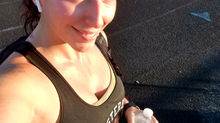Ain't Nothing Gonna Break My Stride: The Importance of a Quick Cadence for Runners
- Claudia Biester

- Feb 15, 2024
- 3 min read
In the world of running, cadence – often referred to as stride rate – is an aspect frequently overlooked by many amateur runners. Yet, it holds immense importance in enhancing performance and reducing injury risk. In this post, we delve into why a quick cadence is crucial for runners and how it can elevate your running game.
What is Cadence?
Firstly, let's understand what cadence means. Cadence in running refers to the number of steps a runner takes per minute (SPM). While there's no one-size-fits-all number, many coaches and experts suggest aiming for a cadence of around 170-180 steps per minute. But why is this number significant?
1. Improved Running Efficiency
A higher cadence is generally associated with increased running efficiency. When you take more steps at a faster rate, each step requires less energy. This is because with quicker, shorter steps, your foot spends less time on the ground, reducing the energy lost in each stride. Efficient running means you can maintain your pace for longer periods, making those long runs or races less taxing on your body.
2. Reduced Injury Risk
Perhaps the most compelling reason to focus on a quick cadence is the potential reduction in injury risk. When your cadence is slower, it usually means you're taking longer strides. Longer strides can lead to overstriding, where your foot lands well ahead of your center of gravity. This not only creates a braking force with each step but also increases the impact on your joints and muscles, potentially leading to injuries like shin splints, runner's knee, and IT band syndrome.
A quicker cadence helps in landing your feet under your body, which aligns better with your center of gravity and reduces the impact on your legs. This alignment is crucial in mitigating the risk of common running-related injuries.
3. Better Muscle Activation
A faster cadence engages different muscle groups more effectively. When you adopt a quicker stride rate, it encourages a midfoot strike rather than a heel strike. This transition engages your calf muscles and the Achilles tendon more efficiently, leading to stronger, more resilient lower leg muscles. Additionally, it can improve your overall form by promoting a more upright posture and a forward lean from the ankles, which is beneficial for both speed and endurance.
4. Enhanced Speed and Performance
For those looking to improve their running times, working on a quicker cadence can be a game changer. Shorter, faster strides can lead to an increase in speed. This doesn't mean you'll tire out quicker; on the contrary, because of improved efficiency and form, you might find that maintaining or even increasing your pace becomes easier.
Tips for Improving Cadence
1. Track Your Cadence: Use a running watch or a smartphone app to measure your current stride rate.
2. Gradual Increase: Don't try to increase your cadence dramatically overnight. Aim for a 5-10% increase to start with.
3. Use Metronomes or Music: Tools like a metronome or songs with the desired beat can help you maintain a consistent pace.
4. Focus on Form: Remember that increasing cadence isn't just about moving your legs faster. Pay attention to your overall running form.
5. Practice Regularly: Like any skill, improving cadence takes practice. Include cadence drills in your regular training.
Incorporating a focus on a quicker cadence can bring about substantial improvements in your running. It's not just about speed; it's about running smarter, more efficiently, and with a reduced risk of injury. Remember, changes should be gradual and always in line with your body's comfort and capability. Happy running; ain't nothing gonna break your stride!




























Comments